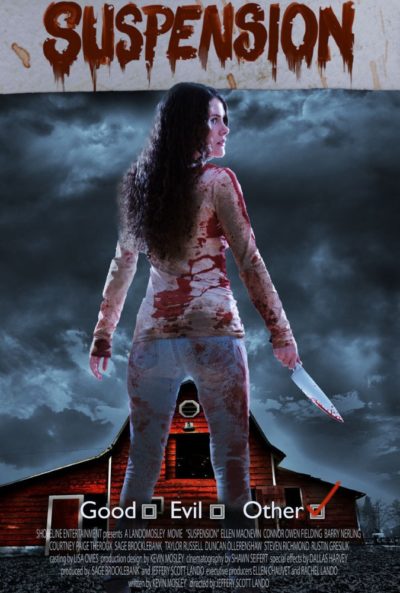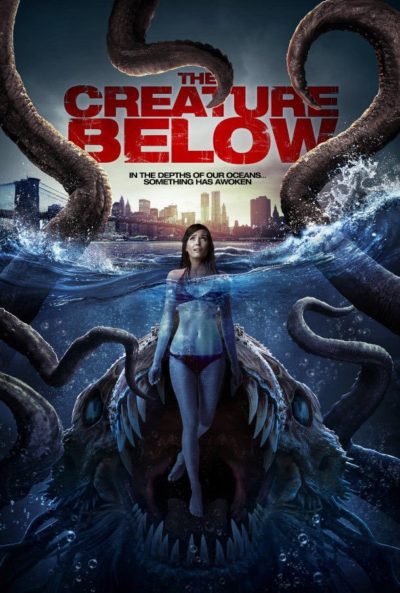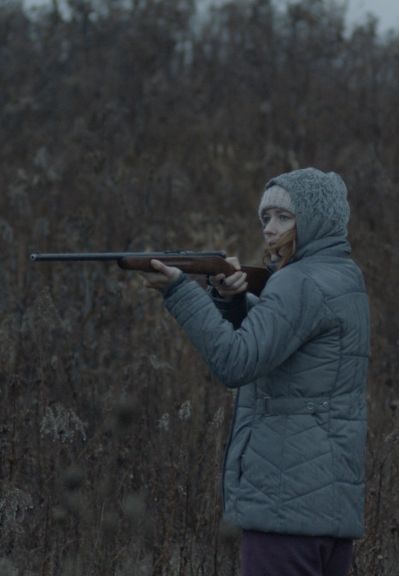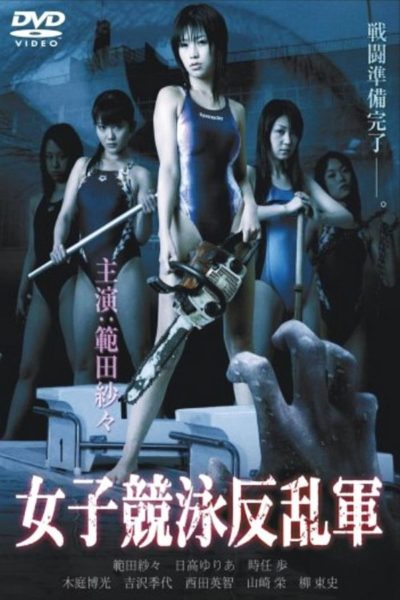★★½
“The night HE came home…”
 Bullied by her peers at high school, Emily (MacNevin) takes refuge in drawing. Although, rather than high art, her preferred method of expression is horror comics: working on these in class is what gets her the titular punishment, imposed by a disapproving teacher. Emily’s strip depicts the havoc wreaked by a serial killer – who might (or might not) be inspired by her absent father. However, the line between imagination and reality becomes blurred, and on the night of a student party to which Emily has not been invited, someone starts stalking and murdering those who have tormented her. Looks like Daddy is out, and protecting his little girl – or, is he?
Bullied by her peers at high school, Emily (MacNevin) takes refuge in drawing. Although, rather than high art, her preferred method of expression is horror comics: working on these in class is what gets her the titular punishment, imposed by a disapproving teacher. Emily’s strip depicts the havoc wreaked by a serial killer – who might (or might not) be inspired by her absent father. However, the line between imagination and reality becomes blurred, and on the night of a student party to which Emily has not been invited, someone starts stalking and murdering those who have tormented her. Looks like Daddy is out, and protecting his little girl – or, is he?
Oh, what the hell: when the sleeve (right) can’t even be bothered to avoid a major spoiler, why should I? Turns out Emily’s mind has snapped entirely, and she’s actually responsible for all the deaths. Otherwise, as my tag-line suggests, there’s more than a little of Halloween here, not least in the look of the killer, whose bland, white mask is more than an echo of the one famously worn by Michael Myers. Indeed, this feels as much of a homage to the slasher films of that era as anything; that’s likely the charitable way to view it, at least, since the supporting characters, situations and even specific kills contain little in the way of originality.
The most interesting thing is likely the effort put into fully developing Emily’s graphic art, beginning with the highly-stylized opening credit sequence. From here, it moves into a female masked killer – I’m guessing, intended to represent Emily’s idealized version of herself – who captures, tortures and dispatches other killers, recording it all on film. It’s a shame this angle isn’t sustained for, to be honest, it’s a good deal more imaginative and possesses a lot more potential, than the rehashed tribute to 80’s horror into which this quickly devolves.
It’s both too much, and not enough – the comic story occupies excessive screen-time in the first half, which could have gone to better development of the “real life” characters or setting. On the other hand, it could also have danced for longer along the line between Emily’s fantasies and reality. Instead, it occupies a mediocre middle, with only one plot element which surprised me – and it was almost a sidelight, not anything to do with Emily’s desire for ultra-violent revenge on her peers. MacNevin isn’t bad in the role; she has a nice, “everygirl” quality about her that generates empathy, along with the devotion she shows to her apparently mute kid brother.
The gore is plentiful enough, and Lando (veteran of many a shaky SyFy Original Movie) has a decent enough eye. The problem is mostly the script, hampered by its apparent unwillingness to commit to being one thing or the other. The result is not a slasher, nor a psychological exploration of homicidal imagination, and instead is a half-baked combo, which satisfies as neither.
Dir: Jeffery Scott Lando
Star: Ellen MacNevin, Taylor Russell, Courtney Paige, Steve Richmond





 After a brief prelude, we first see the heroine Emilia (Todisco) tied in the back of a car belong to her abductor, Sean (Fenton), who is nearby digging what appears disturbingly like a grave. He is seriously unhinged and driven by his loony religious faith to punish those whom he perceives as deserving the wrath of God. Which in this case would be Emilia and her boyfriend, Michael (Sless). Emilia’s first escape attempt does not end well, and she finds herself in the hole in the ground, handcuffed to the corpse of her boyfriend. Now what?
After a brief prelude, we first see the heroine Emilia (Todisco) tied in the back of a car belong to her abductor, Sean (Fenton), who is nearby digging what appears disturbingly like a grave. He is seriously unhinged and driven by his loony religious faith to punish those whom he perceives as deserving the wrath of God. Which in this case would be Emilia and her boyfriend, Michael (Sless). Emilia’s first escape attempt does not end well, and she finds herself in the hole in the ground, handcuffed to the corpse of her boyfriend. Now what? After a long absence, Wynonna Earp (Scrofano) returns to her home town of Purgatory, near the Rockies. There, we discover the truth about the death of her father and disappearance of her sister, events which precipitated Wynonna’s departure. Turns out the great-great-granddaughter of the legendary Wyatt Earp has a supernatural duty to fulfill, using her ancestor’s equally legendary 16-inch barrel “Peacemaker” revolver. Wyatt kept demons known as “revenants” in check, and the mission has been passed down the family line since, with Wynonna the current incumbent. Fortunately, mystical borders keep the revenants within the “Ghost River Triangle,” and she has the help of Deputy Marshal Xavier Dolls (Anderson), an agent in the “Black Badge” division of the US Marshals Service; Doc Holliday (Rozon), the now-immortal former friend of Wyatt; and Wynonna’s kid sister, Waverly (Provost-Chalkley).
After a long absence, Wynonna Earp (Scrofano) returns to her home town of Purgatory, near the Rockies. There, we discover the truth about the death of her father and disappearance of her sister, events which precipitated Wynonna’s departure. Turns out the great-great-granddaughter of the legendary Wyatt Earp has a supernatural duty to fulfill, using her ancestor’s equally legendary 16-inch barrel “Peacemaker” revolver. Wyatt kept demons known as “revenants” in check, and the mission has been passed down the family line since, with Wynonna the current incumbent. Fortunately, mystical borders keep the revenants within the “Ghost River Triangle,” and she has the help of Deputy Marshal Xavier Dolls (Anderson), an agent in the “Black Badge” division of the US Marshals Service; Doc Holliday (Rozon), the now-immortal former friend of Wyatt; and Wynonna’s kid sister, Waverly (Provost-Chalkley). The mad scientist has been a staple of horror/SF for almost 200 years, since Victor Frankenstein first cranked up his machine. The worlds of literature and cinema have frequently returned to it since. A survey showed mad scientists or their creations to be the threat in 30% of horror films over a fifty-year period, and examples from one or other, include Dr. Moreau, Dr. Jekyll, Herbert West, and Rotwang in Metropolis. But they have been almost exclusively male: after Frankenstein, it was 75 years before any comparable female character existed, the title character in George Griffith’s Olga Romanoff, from 1893. They have been rare ever since, with only the occasional entry such as Lady Frankenstein to break male domination.
The mad scientist has been a staple of horror/SF for almost 200 years, since Victor Frankenstein first cranked up his machine. The worlds of literature and cinema have frequently returned to it since. A survey showed mad scientists or their creations to be the threat in 30% of horror films over a fifty-year period, and examples from one or other, include Dr. Moreau, Dr. Jekyll, Herbert West, and Rotwang in Metropolis. But they have been almost exclusively male: after Frankenstein, it was 75 years before any comparable female character existed, the title character in George Griffith’s Olga Romanoff, from 1893. They have been rare ever since, with only the occasional entry such as Lady Frankenstein to break male domination. A viral plague has decimated mankind, turning its victims in mindless, flesh-craving ghouls. One of the few to have survived is Ann (Walters), who has taken up residence in the woods, where she has camped out. Ann uses the survival skills she received from her now-absent husband, Jason (West), only occasionally having to emerge and risk the threat of the infected, in order to gather supplies. Her secluded, yet relatively safe existence is disturbed, when she finds an injured man, Chris (Thompson) and his teenage daughter, Liv (Piersanti) on a road. They are supposed to be on their way north, to where the epidemic is reported to be in check. Yet Chris, in particular, seems curiously unwilling to be on his way.
A viral plague has decimated mankind, turning its victims in mindless, flesh-craving ghouls. One of the few to have survived is Ann (Walters), who has taken up residence in the woods, where she has camped out. Ann uses the survival skills she received from her now-absent husband, Jason (West), only occasionally having to emerge and risk the threat of the infected, in order to gather supplies. Her secluded, yet relatively safe existence is disturbed, when she finds an injured man, Chris (Thompson) and his teenage daughter, Liv (Piersanti) on a road. They are supposed to be on their way north, to where the epidemic is reported to be in check. Yet Chris, in particular, seems curiously unwilling to be on his way. This crisp little Argentinian film clocks in at 70 minutes – not even enough to be considered a feature by the Screen Actors Guild. You’ll understand, therefore, there isn’t much fat on its bones. Virginia (Cardinali) has left her husband, taking daughter, Rebecca (Duranda), with her. But a moment’s inattention at a gas-station proves fatal, as Rebecca is abducted, and Virginia’s car driven off the road during the subsequent pursuit. Brought back (from the dead?) by a mysterious stranger (Ferro), she is told Rebecca has been chosen by a religious cult as a sacrifice. It’s up to Virginia to stop them, and she can let no-one get in her way. Which becomes an issue, for we quickly find out, she is not the only mother looking to recover a child from the cult – and, it appears, only one can succeed.
This crisp little Argentinian film clocks in at 70 minutes – not even enough to be considered a feature by the Screen Actors Guild. You’ll understand, therefore, there isn’t much fat on its bones. Virginia (Cardinali) has left her husband, taking daughter, Rebecca (Duranda), with her. But a moment’s inattention at a gas-station proves fatal, as Rebecca is abducted, and Virginia’s car driven off the road during the subsequent pursuit. Brought back (from the dead?) by a mysterious stranger (Ferro), she is told Rebecca has been chosen by a religious cult as a sacrifice. It’s up to Virginia to stop them, and she can let no-one get in her way. Which becomes an issue, for we quickly find out, she is not the only mother looking to recover a child from the cult – and, it appears, only one can succeed. The horror genre has a tangential connection to the action heroine one, most directly through the concept of the “final girl” – when the last person left alive is a woman who confronts and defeats the threat. From Halloween to Alien, this has been a staple of the genre, but whether it qualifies a film for inclusion here, depends largely on what has gone before. For example, 10 minutes of frantic action at the end can’t counterbalance the first 80, if the focus there was not on a female lead.
The horror genre has a tangential connection to the action heroine one, most directly through the concept of the “final girl” – when the last person left alive is a woman who confronts and defeats the threat. From Halloween to Alien, this has been a staple of the genre, but whether it qualifies a film for inclusion here, depends largely on what has gone before. For example, 10 minutes of frantic action at the end can’t counterbalance the first 80, if the focus there was not on a female lead. I strongly prefer the alternative name (as given in the credits below, though in some territories this was also known as Inglorious Zombie Hunters) – it’s one of the finest exploitation titles of all time, both describing exactly what the film is about, while simultaneously reeling in the potential viewer. Certainly beats something which sounds more like an Asylum “mockbuster” version of a certain, snarky Marvel superhero. If the product itself doesn’t quite live up to it’s own name, this mostly a case of, really, how could it?
I strongly prefer the alternative name (as given in the credits below, though in some territories this was also known as Inglorious Zombie Hunters) – it’s one of the finest exploitation titles of all time, both describing exactly what the film is about, while simultaneously reeling in the potential viewer. Certainly beats something which sounds more like an Asylum “mockbuster” version of a certain, snarky Marvel superhero. If the product itself doesn’t quite live up to it’s own name, this mostly a case of, really, how could it? Right from the start, it’s established that Venus (Kendra) is not the most mentally stable of creatures, alternating between emotional fits in the bathtub, drug abuse and her day job as a stripper. That’s pretty much the trifecta of Stay Away for any man. But she ends up dating one of her strip-club customers, Brian (Naismith), a photographer who likes Venus because… she reminds him of his late wife. Which as opening lines go, I’d imagine would rank highly as Stay Away for any woman. While initially working far better than you’d expect, that only makes the eventual crash and burn of their relationship, all the more brutal.
Right from the start, it’s established that Venus (Kendra) is not the most mentally stable of creatures, alternating between emotional fits in the bathtub, drug abuse and her day job as a stripper. That’s pretty much the trifecta of Stay Away for any man. But she ends up dating one of her strip-club customers, Brian (Naismith), a photographer who likes Venus because… she reminds him of his late wife. Which as opening lines go, I’d imagine would rank highly as Stay Away for any woman. While initially working far better than you’d expect, that only makes the eventual crash and burn of their relationship, all the more brutal. Stumbled across this low-budget horror flick almost by accident when I was Googling the similarly-titled but very different,
Stumbled across this low-budget horror flick almost by accident when I was Googling the similarly-titled but very different,